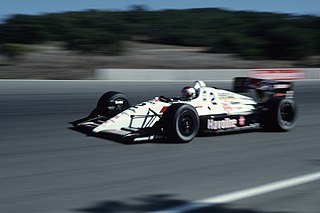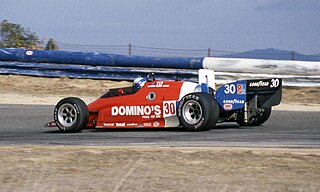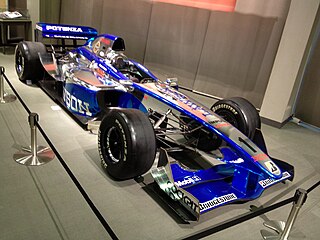Related Research Articles

The Lola T290, and its evolutions, the T292, T294, T296, T297, T298, and T299, are a series of Group 5 Sports 2000 prototype race cars, designed and developed by Bob Marston, John Barnard, Patrick Head, and Eric Broadley, and built by British manufacturer and constructor Lola, for European 2-Litre Championship sports car racing series, between 1972 and 1981.
The Lola T100 is a Formula 2 single-seater entered by German BMW team for the 1967 German Grand Prix, the seventh round of the 1967 Formula One World Championship. Designed by British manufacturer Lola Cars, led by engineer Eric Broadley, the T100 was raced by Britons David Hobbs and Brian Redman. A version adapted to the technical regulations of Formula 1 was also driven by German Hubert Hahne.
The Lola T102, also known as the BMW T102, is a Formula 2 car, designed, developed and built by Lola Cars, under the leadership and guidance of Eric Broadley. It competed between 1968 and 1969. It entered and competed in one Formula One Grand Prix; the 1968 German Grand Prix; where German driver Hubert Hahne finished in tenth place.

The Lola T90/00 is a highly successful open-wheel racing car chassis, designed and built by Lola Cars that competed in the CART open-wheel racing series, for competition in the 1990 season. It was extremely competitive, winning a total of 12 races that season, including a win for Dutchman Arie Luyendyk at the prestigious Indianapolis 500. It also gave American Al Unser Jr. his first of two IndyCar World Championships, with Galles-Kraco Racing. It was powered by the 735–800 hp (548–597 kW) Ilmor-Chevrolet 265-A turbo engine.
The Lola T150, and it's the deriatives, the T152 and T153, were open-wheel racing car chassis, designed and built by Lola Cars to compete in USAC IndyCar racing series, between 1968 and 1970. The T150 and T153 were powered by the 159 cu in (2.61 L) 780–900 hp (580–670 kW) Ford Indy V-8 turbo engine; while the T152 chassis used a 159 cu in (2.61 L) 900 hp (670 kW) Offenhauser 4-cylinder turbo engine. Both the T150 and T152 used a unique four-wheel-drive system, which would be banned after the 1969 season. The T153 only used a conventional two-wheel-drive (rear-wheel-drive setup. The different chassis would, over the span of three years, win a total of 9 races, all while being driven by Al Unser.

The Lola T91/00 is a highly successful open-wheel racing car chassis, designed and built by Lola Cars that competed in the CART open-wheel racing series, for competition in the 1991 IndyCar season. It was the most dominant car that season, and extremely competitive, winning a total of 15 out of the 17 races during the 1991 season, with Michael Andretti enjoying the most considerable success, scoring 8 wins, taking 8 pole positions, and leading more laps than any other driver that season. Al Unser Jr. and Arie Luyendyk scored 2 wins, while Bobby Rahal and John Andretti scored one win each. Even though Bobby Rahal won only one race, he had 11 podium finishes, and 13 top 10s, making him a very serious challenger and competitor for the title that year. Michael Andretti eventually went on to win the 1991 IndyCar World Drivers' Championship with this car. It was powered by the 720–800 hp (540–600 kW) Ilmor-Chevrolet 265-A turbo engine.

The Lola T90 is a highly successful and competitive open-wheel racing car chassis, designed and built by Lola Cars to compete in USAC IndyCar racing series, that successfully won the 1966 Indianapolis 500, being driven by Graham Hill. It was powered by either the 425–500 hp (317–373 kW), naturally-aspirated, 256 cu in (4.20 L), Ford Indy V-8 engine, or the 168 cu in (2.75 L), 520 hp (390 kW), Offenhauser 4-cylinder turbo engine.

The Lola T900 is an open-wheel racing car chassis, designed and built by Lola Cars that competed in the CART open-wheel racing series, for competition in the 1985 IndyCar season. It won a total of 5 races that season, with Al Unser Jr. taking 2 wins, and Mario Andretti taking 3 wins, while narrowly missing out on another win at that year's Indianapolis 500. It was powered by the 800 hp (600 kW) Ford-Cosworth DFX.
The Lola T160 is a series of purpose-built Group 7 sports prototype race cars, designed and developed by British chassis manufacturer Lola Cars, specifically to compete in the Can-Am series in 1968. It was the successor to the competitive T70, sharing similar design knowledge and cues. Lola built the chassis, constructed out of fiberglass, and molded into an aluminum monocoque. This meant the car was light was lightweight, weighing only 670 kg (1,480 lb). The chassis was designed to accept a small-block engine, but most cars were powered by either the Chevrolet ZL1 or the Ford FE "big-block" motors, generating about 625–750 hp (466–559 kW); mated to a 4-speed or 5-speed Hewland L.G.500 or L.G.600 manual transmission. This made the cars very fast, with a notably excellent power-to-weight ratio. It was used in active competition until 1971, and was succeeded and used alongside the new T220 in 1970.

The Lola Mk1 is the first sports racing car made by Lola, under the leadership and guidance of Eric Broadley, in 1958. The body was designed and developed by chief stylist Maurice Gomm, made out of a steel or fiberglass tubular spaceframe chassis, covered in a low-profile, sleek, aluminum skin. The 80 hp (60 kW), 1,098 cc (67.0 cu in), Coventry Climax FWA four-cylinder engine was designed by Harry Mundy and Walter Hassan. The car used a 4-speed manual transmission, and was lightweight, only weighing in at a mere 812–840 lb (368–381 kg). It also notably won its class at the 1960 12 Hours of Sebring, being driven by Charles Vögele and Peter Ashdown. At least 32 cars were known to have been built, but the actual number is believed to be between 38 and 42.
The Lola T530 is a purpose-built Can-Am sports prototype, designed by British manufacturer Lola Cars in for the revived Can-Am series 1980. It was very successful, winning 7 of the 9 races in its first season of competition alone, and gave Patrick Tambay the championship with Carl A. Haas racing Team. Geoff Brabham won the championship in 1981; despite only winning 2 races. It was used in Can-Am racing until 1983. It was later used in the international Interserie racing series, and the British Thundersports racing series, between 1984 and 1988. Between 1980 and 1988, it scored a total of 32 race wins, and 43 podium finishes; a very impressive tally indeed. As with all other full-size Can-Am cars of the time, it used a mid-mounted 5-liter, naturally-aspirated, Chevrolet V8 engine. A total of 10 chassis' were built.

The Lola T800 is an open-wheel racing car chassis, designed and built by Lola Cars that competed in the CART open-wheel racing series, for competition in the 1984 IndyCar season. The T800 was the Newman Haas Racing team's emergency vehicle in the CART series. The Newman-Haas team, founded by Paul Newman and Carl Haas in 1983, was only in its second season when it fielded the best-of-season vehicle, the T800. The Monoposto was powered by a Cosworth turbo engine and was driven by Mario Andretti and Danny Sullivan. From Andretti's maiden win at Meadowlands, he and Sullivan won eight straight races, with Andretti winning five times and Sullivan winning three races. However, the two drivers were unable to win the most important race of the year, the Indianapolis 500-mile race. At Indianapolis Motor Speedway, winner Rick Mears led a phalanx of five March 87Cs. Andretti secured the 1984 CART championship with the T800. It was powered by the 800 hp (600 kW) Ford-Cosworth DFX.

The Lola B06/51, also known as the Lola FN06, is an open-wheel formula racing car, designed, developed and built by Lola for the Japanese Formula Nippon championship series, in 2006.

The Lola T700 is an open-wheel racing car chassis, designed, developed and built by Lola Cars, that competed in the CART open-wheel racing series, for competition in the 1983 IndyCar season. It was powered by the 700 hp (520 kW) Ford-Cosworth DFX. It won two Grand Prix that season, at Road America and Caesars Palace, both while being driven by Mario Andretti. Only 3 models were produced. It did manage to score 6 podium finishes, also all with Andretti. Andretti eventually finished the season championship that year in 3rd-place, with 133 points.
The Lola T270, and its variant and derivative, the Lola T270 are open-wheel racing car chassis, designed, developed and built by Lola Cars, that competed in the CART open-wheel racing series, for competition in the 1972 and 1973 USAC Championship Car seasons. It didn't win any races, with its best race result being a 2nd-place finish; being driven by Wally Dallenbach at Michigan in 1972. Its best Indianapolis 500 result was a 4th-place finish; being driven by Sam Sessions, in the 1972 race. It was powered by three different engines; including Ford and Foyt-badged Ford V8 turbo engines, or an Offenhauser four-cylinder turbo engine.
The Lola B01/00 is an open-wheel racing car chassis, designed and built by Lola Cars that competed in the CART open-wheel racing series, for competition in the 2001 season. It scored a total of 10 race wins that season, with Swede Kenny Bräck eventually finishing in second place, as runner-up in the championship, with 163 points in this car.

The Lola T210, and its evolution, the Lola T212, are Group 6 sports prototype race cars, designed, developed and built by British manufacturer Lola, for the newly created European 2-Litre sports car racing championship, in 1970.
The Lola T220, and its evolution, the Lola T222, are Group 7 sports prototype race cars, designed, developed, and built by the British manufacturer and constructor Lola, to compete in the Can-Am championship from the 1971 season. It also took part in the European Interserie championship.

The Lola T280, and its evolutions, the Lola T282, Lola T284, and Lola T286, are a series of 3-liter Group 5 sports prototype race cars, designed by Eric Broadley, John Barnard, and Patrick Head, and developed and built by British manufacturer and constructor Lola, for World Sportscar Championship sports car racing, between 1972 and 1976.

The Lola T380 is a 3-litre Group 5 sports prototype, designed, developed and built by British manufacturer and constructor Lola, for sports car racing, in 1975.
References
- ↑ "1975 Lola T390 Ford Specifications". Ultimatecarpage.com.
- ↑ "Lola Heritage". www.lolaheritage.co.uk.
- ↑ "Lola Heritage". www.lolaheritage.co.uk.
- ↑ "Lola T390" . Retrieved 24 September 2022.
- ↑ "Lola T390". www.racecarsdirect.com.